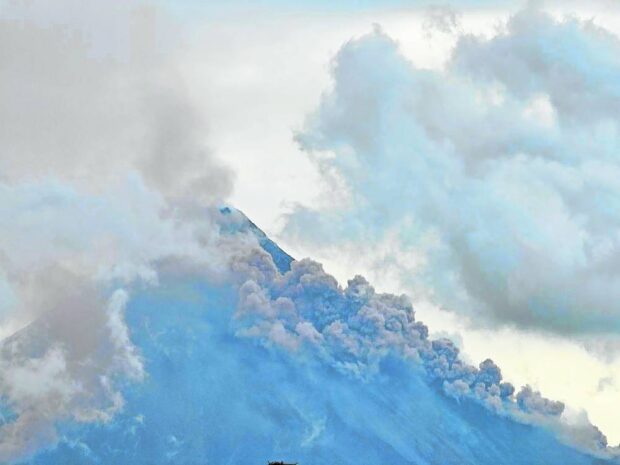Albay folk brace anew for Mayon volcano’s lahar flow

INCREASED ACTIVITY Mayon Volcano continuously generates pyroclastic density currents and lava flow as seen in this photo taken at 5:40 p.m. on July 10 in Daraga, Albay. —PHOTO CONTRIBUTED BY DENNIS MIRABUENO
LEGAZPI CITY—Families living near the river channels around Mayon Volcano were warned anew of possible lahar flow as Tropical Depression “Egay” was expected to bring heavy rainfall and thunderstorms in the Bicol region and other parts of Luzon.
The Philippine Institute of Volcanology and Seismology (Phivolcs) on Friday said heavy rainfall may generate “syn-eruption” lahar, or those that are triggered by a primary volcanic activity, along major channels with loose materials emitted by the ongoing effusive eruption of the Mayon Volcano.
In a lahar advisory on Friday, Phivolcs said “the bulk of erodible pyroclastic density current deposits” in Mi-isi, Bonga and Basud channels could be mobilized by heavy rains.
Paul Karson Alanis, resident volcanologist of Phivolcs in Legazpi, said the volcano released about 16 to 17 million cubic meters of materials composed of lava, rocks and volcanic ash as of Thursday.
Alanis said most of these materials were deposited in Mi-isi gully in Barangay Mi-isi in Daraga town and Bonga gully in Barangay Bonga in Legazpi City.
Article continues after this advertisement“[The debris] deposited in the Basud gully in Sto. Domingo was wider, but the lava flow was concentrated in Mi-isi at Bonga gullies,” Alanis said in a private message on Friday.
Article continues after this advertisementHe said the thick lava emitted by the volcano could still be mobilized by the heavy rains.
Phivolcs said potential lahar and sediment-laden streamflows may occur in the river channels in Mi-isi and Binaan in Daraga town; Anoling and Quirangay in Camalig; Maninila, Masarawag and Muladbucad in Guinobatan; Nasisi in Ligao City; Mabinit and Matanag in Legazpi City; and Basud in Sto. Domingo town.
Cedric Daep, chief of the Albay Public Safety and Emergency Management Office, said the old deposits from the 2018 eruption could be a bigger threat if mobilized by heavy rains along the river channels.
“[About] 60 millimeters per hour of rainfall [could trigger] Mayon volcano’s lahar but since there are new deposits, it could adjust the threshold,” Daep said in a text message on Friday.
Alanis said there were about 60 million cu. m of volcanic debris emitted by the volcano on Jan. 13, 2018.
On alert
In the 11 a.m. bulletin on Friday, the Philippine Atmospheric, Geophysical and Astronomical Services Administration (Pagasa) said Egay could intensify into a super typhoon by July 24.
Its center was last seen 900 kilometers east of southeastern Luzon, packing a maximum sustained winds of 55 km per hour (kph) near the center and gust of up to 70 kph.
Melvin Almojuela, weather forecaster of Pagasa Southern Luzon, said the trough of Egay triggered light to moderate rains in the Bicol region, while localized thunderstorms also affected the province of Albay.
As of Friday, Pagasa has yet to hoist wind signals over any area in the Bicol region.
But the Office of Civil Defense (OCD) Bicol on Friday placed the region under red alert status and activated the emergency operations center for preemptive measures.
Claudio Yucot, director of OCD Bicol, said local officials were advised to evacuate families in high-risk areas, including places prone to flood, landslide and lahar.
At least 20,000 individuals from Mayon volcano’s danger zones have been evacuated since June 9, a day after Phivolcs raised alert level 3 over Mayon, which indicated a possible hazardous eruption. They are currently staying in temporary shelters in the towns of Malilipot, Sto. Domingo, Daraga, Camalig and Guinobatan; and the cities of Tabaco and Ligao.
RELATED STORY:
Tropical Depression Egay almost stationary, possible super typhoon intensity by Tuesday